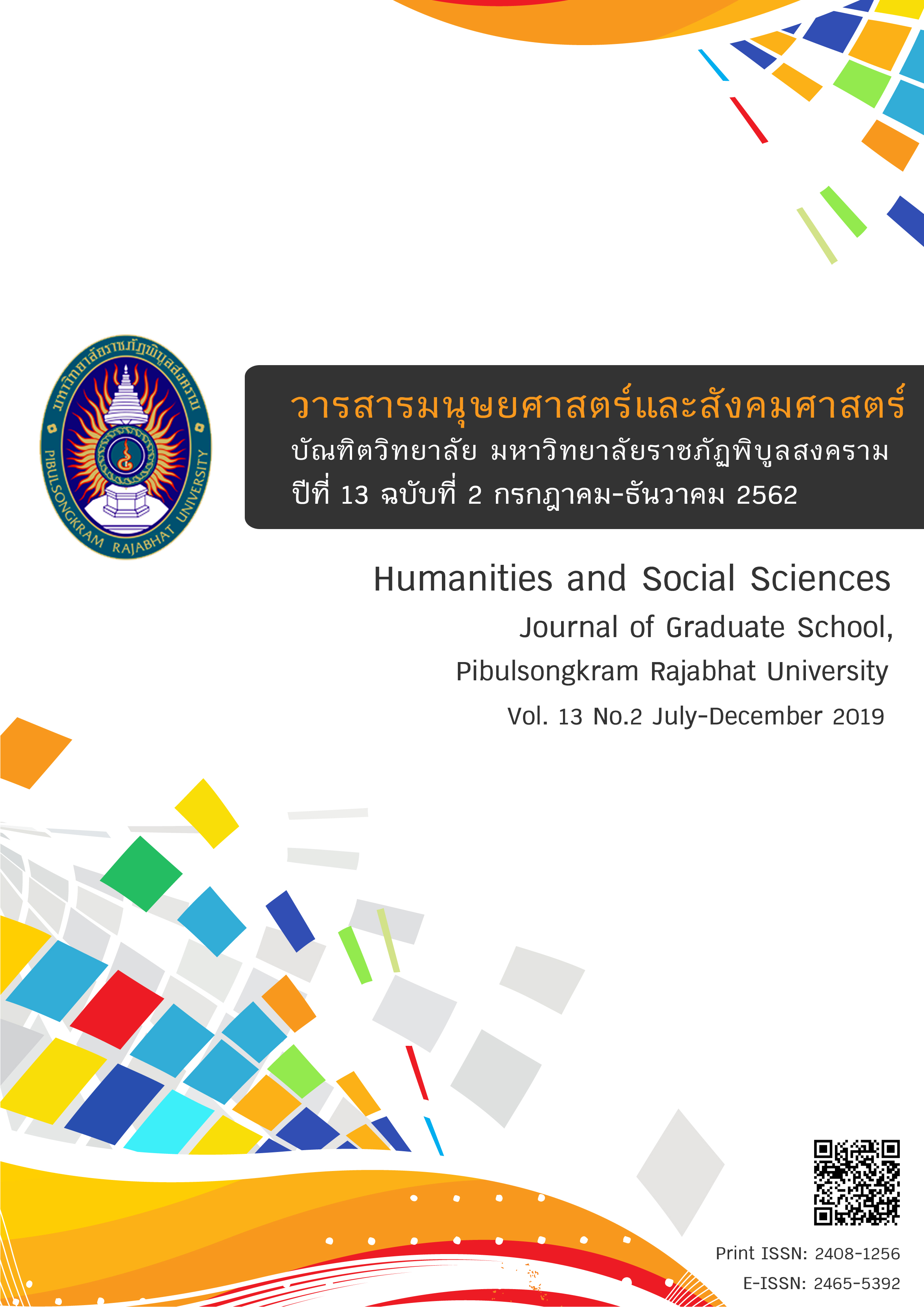Increasing EFL Students’ English Reading Ability and Engagement through Multimodal Learning Environments
Keywords:
การจัดการเรียนรู้แบบสื่อประสม, ความสามารถด้านการอ่าน, ทัศนคติAbstract
Reading is considered a crucial life skill; however, it is difficult to motivate students to read inside or outside the English as a foreign language (EFL) classroom. This research study was designed to engage EFL students in a reading class, investigating the impact of multimodal learning environments on EFL students’ reading ability and its relationship to their attitudes towards English reading. To ensure accuracy and reliability of results, the experiment was conducted at two universities in different locations: Bangkok and Nakhon Phathom. The participants were 64 undergraduate students. The instruments used in this study included lesson plans, a reading test, and questionnaires. Mean scores, standard deviations, two ways analysis of variance, and a t-test analysis were used to analyze the data. The results from both locations were similar specifically students in the experimental groups had significantly higher reading test scores and more positive attitudes towards English reading than those of the control groups, indicating that multimodal learning environments were effective in EFL classes. This consistency of findings at both universities confirms that multimodal learning environments facilitated both high-and low-achieving students’ learning and supported students with different backgrounds.
References
Bradwell, P. (2009). The edgeless university: Why higher education must embrace technology. London, UK: DEMOS think thank.
Chareonwongsak, K. (2002, July 7). Ten dimensions for new Thai thinking skills. Bangkok Post, p. 4.
Chen, G., & Fu, X. (2003). Effects of multimodal information on learning performance and judgment of learning. Journal of Educational Computing Research, 29(3), 349-362.
Chinwonno, A. (2001). A comparison of Thai and English reading comprehension strategies of pre-service teachers in Thailand (Unpublished dissertation). Ohio University, Ohio.
Cohen, J. (1988). Statistical power analysis for the behavioral sciences (2nd ed.). Hillsdale, NJ: Erlbaum.
Daniels, H. (2001). Vygotsky and pedagogy. London: Routledge.
Dunn, R., & Griggs, S. A. (2003). Synthesis of the Dunn and Dunn learning style model: who, what, when, where, and so what? New York: Center for the Study of Learning and Teaching Styles, St John’s University.
Fadel, C. (2008). Multimodal learning through media: What the research says. San Jose, CA: CiscoSystems.
Falk-Ross, F. (2014). Language-based approaches to support reading comprehension. Lanham, Maryland: Rowman & Littlefield Publishers.
Farías, M., Obilinovic, K., & Orrego, R. (2011). Engaging multimodal learning and second/foreign language education in dialogue. Trabalhos de Lingüística Aplicada, 50(1), 133-151.
Ganapathy, M. (2014). Using multiliteracies to engage learners to produce learning. IJEEEE, 4(6), 410-422.
Ganapathy, M., & Seetharam, S. (2016). The effects of using multimodal approaches in meaning-making of 21st century literacy texts among ESL students in a private school in Malaysia. Advances in Language and Literary Studies, 7(2), 144-155.
Jenson, E. (2005) Teaching with the brain in mind. Alexandria, VA: Association for Supervision and Curriculum Development.
Jewitt, C. (2006). Technology, literacy and learning: A multimodal approach. London: Routledge.
Kesler, T. (2011). Expanding pre-service teachers’ conceptions of texts, readers, and response through multimodal response. Language and Literacy, 13(1), 72-94.
Kress, G., & van Leeuwen, T. (2001). Multimodal discourse: The modes and media of contemporary communication. Oxford UK: Oxford University Press.
Kullberg, B. (2010). En etnografisk studie i en Thailändsk grundskola på en ö isödra Thailand:
i sökandet efter en framtid då nuet har nog av sitt (Unpublished Dissertation). Göteborgs, Universitet, Göteborg.
Lauer, C. (2009). Contending with terms: “multimodal” and multimedia” in the academic and public spheres. Computers and Composition, 26(4), 225-239.
Lee, H. (2014). Using an arts-integrated multimodal approach to promote English learning:
A case study of two Taiwanese junior college students. English Teaching: Practice and Critique, 13(2), 55-75.
Lizzio, A., Wilson, K., & Simons, R. (2002). University students' perceptions of the learning environment and academic outcomes: Implications for theory and practice. Studies in Higher Education, 27, 27-52.
Lorence, L. (2008). Tips from the pros–three strategies for engaging students through multimodal course design. Retrieved on July 26, 2017, from http://www.magnapubs.com/newsletter/onlineclassroom/55/tips
Mayer, R. E. (2003). Elements of a science of E-learning. Journal of Educational Computing Research, 29(3), 297-313.
McCarthy, M. (2001). Issues in applied linguistics. Cambridge, Cambridge University Press.
Merrill, M. D. (2002). First principles of instruction. Educational Technology, Research and Development, 50(3), 43-59.
Moreno, R., & Mayer, R. (2007). Interactive multimodal learning environments. Educational Psychological Review, 19, 309-326.
Nitsaisook, M. (2002). A study of Thai students' EFL reading literacy (Unpublished thesis). Burapha University, Chonburi. (in Thai)
Rattanawanitpun, S. (1999). A study of Thai university students' ability to use Multiple standards to evaluate their comprehension of expository texts in English (Unpublished dissertation). Southern Illinois University at Carbondale, Illinois.
Sankey, M., Birch, D., & Gardiner, M. (2010). Engaging students through multimodal learning environments: The journey continues. Proceedings from ASCILITE 2010: 27th Annual Conference of the Australasian Society for Computers in Learning in Tertiary Education: Curriculum, Technology and Transformation for an Unknown Future. Sydney, Australia: University of Southern Queensland.
Shah, P., & Freedman, E. G. (2003). Visuospatial cognition in electronic learning. Journal of Educational Computing Research, 29(3), 315-324.
Shepard, C. (2013). Multimodal approaches to teaching reading in Hong Kong primary classrooms. Proceedings from The Future of Education Conference. Florence, Italy.
Solvie, P., & Kloek, M. (2007). Using technology tools to engage students with multiple learning styles in a constructivist learning environment. Contemporary Issues In Technology And Teacher Education, 7(2), 7-27.
Sulphey, M. M. (2017). Game based learning as an aid for extenuating Higher Education Sector issues–The case of Saudi Arabia. International Journal of Simulation, Systems, Science and Technology, 18(1), 6.1-6.10.
The Office of the National Education Center. (1996). The national education policy 1997-2001 (No. 8). Bangkok, Thailand: Atthapornkarnpim.
Tolley, L. M., Johnson, L., & Koszalka, T. A. (2012). An intervention study of instructional methods and student engagement in large classes in Thailand. International Journal of Educational Research, 53, 381-393.
Woolley, G. (2010). COR Framework: A multiple strategy reading comprehension intervention project: program notes and supplementary materials. A joint partnership: Griffith University and Independent Schools Queensland.
Yunus, M. M., Salehi, H., & John, D. S. A. (2013). Using visual aids as a motivational tool in enhancing students’ interest in reading literary texts. In International conference; 4th, Education and educational technologies; Recent advances in educational technologies; 2013; Cambridge, MA (p. 114-117). Greece: WSEAS Press.
Downloads
Published
How to Cite
Issue
Section
License
บทความหรือข้อคิดเห็นใดใดที่ปรากฏในวารสารมนุษยศาสตร์และสังคมศาสตร์ มหาวิทยาลัยราชภัฏพิบูลสงครามเป็นวรรณกรรมของผู้เขียน ซึ่งบรรณาธิการไม่จำเป็นต้องเห็นด้วย บทความที่ได้รับการตีพิมพ์เป็นลิขสิทธิ์ของวารสารมนุษยศาสตร์และสังคมศาสตร์ มหาวิทยาลัยราชภัฏพิบูลสงคราม







